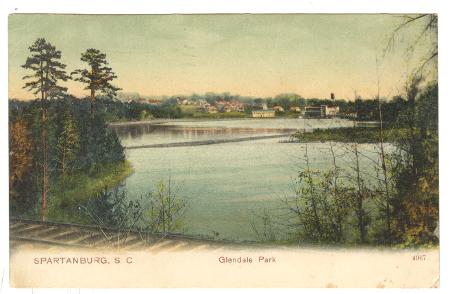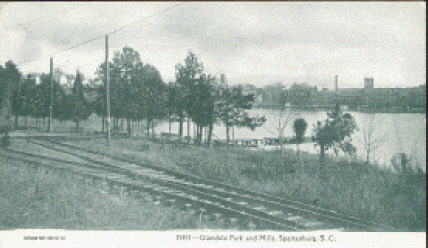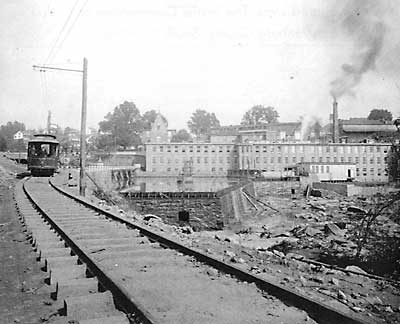The Trolley Line
Along with trains that provided a complete inter-city and inter-state service, passengers within the city and its suburbs now found they had a rapid-transit, street-railway system that was equal or better than any city of comparable size in the South. It was an extensive network of tracks, linking Spartanburg's central business section with most of its residential neighborhoods. Spartanburg's street railway system, however, had extended its network of electrified tracks as far as they would ever go by 1915-16; in fact, a section of track between Clifton No.1 and Converse that was washed away in the great 1903 Pacolet River flood was never rebuilt.
From a dispatching center near the Union station, trolleys moved up Magnolia Street to Morgan Square. From this central point, tracks fanned out on routes that led to the north, south, east, and west. The longest route followed East Main to its intersection with Pine Street; there, in the summer months, one branch continued east to the Rock Springs amusement park, at the present location of White's Mill on Heywood Avenue. On a year-round basis, however, the principal part of the route continued on Pine Street to the East Spartanburg "car barn" and shops, then turned east through Ben Avon and past the Spartanburg Country Club to Glendale. Street cars then completed the journey on a right-of-way (still visible in places) that connected Glendale with the Clifton No.1 village. The tracks that at the time led from Clifton No.1, around one of the big bends of the Pacolet River to Clifton No.3 (Converse), were in the section destroyed in the flood of June 6, 1903.
The street car, or trolley, service to Glendale was very important to the town of Glendale. It provided a quick and convenient way to travel to downtown Spartanburg or other stops along the way. It also provided a way for freight to be shipped in and out of Glendale. There were both passenger and freight cars on the line. Glendale was one of the few textile towns in the upstate to be without railroad service. Before the coming of the streetcar system, freight was shipped in and out of Glendale on heavy wagons. This was often taken to the nearest railroad connection near Whitestone or what was to become Camp Croft. The coming of the streetcar changed that.
The steetcar system was built by the Spartanburg Railway, Gas and Electric Company. In the early 1900's, the company also brought another bonus to the Glendale area. It built a public park near the site of the old Iron Works and named it Glendale Park. They built a large pavilion at the park and it became a popular site for visitors not only from Glendale but from all over the Spartanburg area. The park was on the large lake formed by the Glendale power dam. Boating was popular on the lake.
The park was often advertised in the Spartanburg Herald as a great place to visit. The following is an ad in the paper from May 20, 1906.
Glendale, The Mecca For The Pleasure Seekers
Through the generous courtesy of Mr. F. D. McEowen, manager of the street railway system, and Mr. B. A. Buckheister * , the popular Superintendent, a picnic at Glendale may be arranged at short notice, in such style as to meet everyone’s approval. The careful, polite conductors, the interested motorman, the clean well- kept cars, ensure a delightful trolley ride, while the pond, the clear brook for wading purposes, the pavilion, the pines, and further on, the beautiful forest, offers every inducement to the young folks who are out for a royal good time.
(* For more information on the Superintendent click on Benjamin Andrew Buckheister.)

The trolley tracks crossed the lake on a trestle and then continued on into the town to run right beside the mill. From Glendale, the trolley continued on to Clifton.

The trolley discontinued operation on April 26, 1935. It was replaced by a bus system. The trolley met its fate because of the coming of paved county roads and improvements in motor vehicles.

(Trolley approaching Clifton)
Note from Web Master Mary Teaster - I feel that I have a personal connection to the trolley. The trolley tracks connecting Glendale with Clifton ran right through my front yard and across our driveway. The track roadbed is very visible right to this day. In addition, my grandfather, Andrew Jackson (Pop) McKinney drove the trolley car for a time.